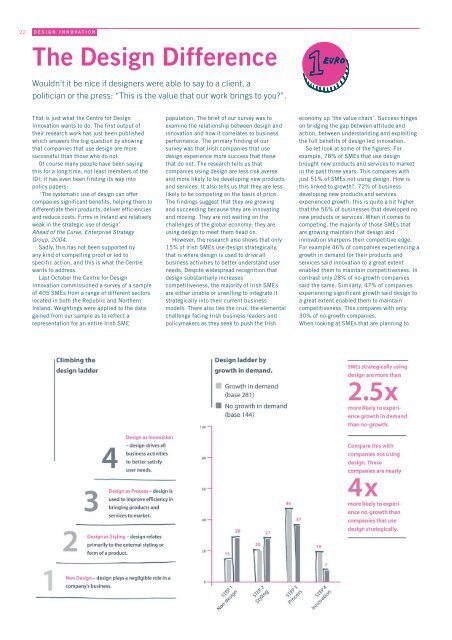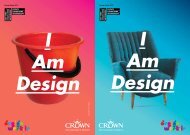22 DESIGN INNOVATIONThe Design DifferenceWouldn’t it be nice if designers were able to say to a client, apolitician or the press: “This is the value that our work br<strong>in</strong>gs to you?”.That is just what the Centre for DesignInnovation wants to do. The first output <strong>of</strong>their research work has just been publishedwhich answers the big question by show<strong>in</strong>gthat companies that use design are moresuccessful than those who do not.Of course many people have been say<strong>in</strong>gthis for a long time, not least members <strong>of</strong> the<strong>IDI</strong>; it has even been f<strong>in</strong>d<strong>in</strong>g its way <strong>in</strong>topolicy papers:‘The systematic use <strong>of</strong> design can <strong>of</strong>fercompanies significant benefits, help<strong>in</strong>g them todifferentiate their products, deliver efficienciesand reduce costs. Firms <strong>in</strong> <strong>Ireland</strong> are relativelyweak <strong>in</strong> the strategic use <strong>of</strong> design’Ahead <strong>of</strong> the Curve, Enterprise StrategyGroup, 2004.Sadly, this has not been supported byany k<strong>in</strong>d <strong>of</strong> compell<strong>in</strong>g pro<strong>of</strong> or led tospecific action, and this is what the Centrewants to address.Last October the Centre for DesignInnovation commissioned a survey <strong>of</strong> a sample<strong>of</strong> 405 SMEs from a range <strong>of</strong> different sectorslocated <strong>in</strong> both the Republic and Northern<strong>Ireland</strong>. Weight<strong>in</strong>gs were applied to the dataga<strong>in</strong>ed from our sample as to reflect arepresentation for an entire Irish SMEpopulation. The brief <strong>of</strong> our survey was toexam<strong>in</strong>e the relationship between design and<strong>in</strong>novation and how it correlates to bus<strong>in</strong>essperformance. The primary f<strong>in</strong>d<strong>in</strong>g <strong>of</strong> oursurvey was that Irish companies that usedesign experience more success that thosethat do not. The research tells us thatcompanies us<strong>in</strong>g design are less risk averseand more likely to be develop<strong>in</strong>g new productsand services. It also tells us that they are lesslikely to be compet<strong>in</strong>g on the basis <strong>of</strong> price.The f<strong>in</strong>d<strong>in</strong>gs suggest that they are grow<strong>in</strong>gand succeed<strong>in</strong>g because they are <strong>in</strong>novat<strong>in</strong>gand mov<strong>in</strong>g. They are not wait<strong>in</strong>g on thechallenges <strong>of</strong> the global economy; they areus<strong>in</strong>g design to meet them head on.However, the research also shows that only15% <strong>of</strong> Irish SMEs use design strategically,that is where design is used to drive allbus<strong>in</strong>ess activities to better understand userneeds. Despite widespread recognition thatdesign substantially <strong>in</strong>creasescompetitiveness, the majority <strong>of</strong> Irish SMEsare either unable or unwill<strong>in</strong>g to <strong>in</strong>tegrate itstrategically <strong>in</strong>to their current bus<strong>in</strong>essmodels. There also lies the crux, the elementalchallenge fac<strong>in</strong>g Irish bus<strong>in</strong>ess leaders andpolicymakers as they seek to push the Irisheconomy up ‘the value cha<strong>in</strong>’. Success h<strong>in</strong>geson bridg<strong>in</strong>g the gap between attitude andaction, between understand<strong>in</strong>g and exploit<strong>in</strong>gthe full benefits <strong>of</strong> design led <strong>in</strong>novation.So let look at some <strong>of</strong> the figures. Forexample, 78% <strong>of</strong> SMEs that use designbrought new products and services to market<strong>in</strong> the past three years. This compares withjust 51% <strong>of</strong> SMEs not us<strong>in</strong>g design. How isthis l<strong>in</strong>ked to growth?. 72% <strong>of</strong> bus<strong>in</strong>essdevelop<strong>in</strong>g new products and servicesexperienced growth, this is quite a bit higherthat the 56% <strong>of</strong> bus<strong>in</strong>esses that developed nonew products or services. When it comes tocompet<strong>in</strong>g, the majority <strong>of</strong> those SMEs thatare grow<strong>in</strong>g ma<strong>in</strong>ta<strong>in</strong> that design and<strong>in</strong>novation sharpens their competitive edge.For example 46% <strong>of</strong> companies experienc<strong>in</strong>g agrowth <strong>in</strong> demand for their products andservices said <strong>in</strong>novation to a great extentenabled them to ma<strong>in</strong>ta<strong>in</strong> competitiveness. Incontrast only 28% <strong>of</strong> no-growth companiessaid the same. Similarly, 47% <strong>of</strong> companiesexperienc<strong>in</strong>g significant growth said design toa great extent enabled them to ma<strong>in</strong>ta<strong>in</strong>competitiveness. This compares with only30% <strong>of</strong> no-growth companies.When look<strong>in</strong>g at SMEs that are plann<strong>in</strong>g to
DESIGNINNOVATION23grow, the research found that these companiesare also more likely to <strong>in</strong>crease their<strong>in</strong>vestment <strong>in</strong> design. 21% <strong>of</strong> Irish SMEssignificantly <strong>in</strong>creased their <strong>in</strong>vestment <strong>in</strong>design <strong>in</strong> the past year. When look<strong>in</strong>g at this<strong>in</strong> relation to growth, it was found that 35%<strong>of</strong> SMEs report<strong>in</strong>g <strong>in</strong>creased turnover havesignificantly <strong>in</strong>creased their <strong>in</strong>vestment<strong>in</strong> design. Look<strong>in</strong>g ahead one year, while43% <strong>of</strong> all SMEs are plann<strong>in</strong>g to <strong>in</strong>creasetheir <strong>in</strong>vestment <strong>in</strong> design, this compareswith 60% for SMEs plann<strong>in</strong>g to grow rapidly<strong>in</strong> the next year.The research also shows that some forms<strong>of</strong> design-use lead to more growth than others.As part <strong>of</strong> this research we adopted a ‘designladder’ model to illustrate that there is animportant dist<strong>in</strong>ction to be made betweenthe different levels at which companies usedesign. The higher the step on the ladder, themore strategic the design implementationwith<strong>in</strong> a company. The research tells us thatthe more strategic the implementation is, themore likely a company is to experience growth<strong>in</strong> demand for their products and services.Currently only 15% <strong>of</strong> Irish SMEs haveachieved the highest rung <strong>of</strong> the ladder,mean<strong>in</strong>g that many more could be target<strong>in</strong>gadditional growth by climb<strong>in</strong>g a little higher.SMEs that strategically use design are 2.5times more likely to experience growth <strong>in</strong>demand for their products/services than nogrowth.This compares with SMEs not us<strong>in</strong>gdesign. These SMEs are nearly 4 times morelikely to experience no-growth than companiesthat use design strategicallyOne <strong>of</strong> the most <strong>in</strong>terest<strong>in</strong>g f<strong>in</strong>d<strong>in</strong>gs from theresearch is that the majority <strong>of</strong> SMEs attitudestowards design is positive, <strong>in</strong> so far as theyperceive that design has the potential to addvalue to their organisation. Yet very few areunwill<strong>in</strong>g or unable to implement it at a morestrategic level. For example 78% <strong>of</strong> SMEsth<strong>in</strong>k that design is important for stay<strong>in</strong>gahead <strong>of</strong> the competition, yet only 15% planto significantly <strong>in</strong>crease their <strong>in</strong>vestment <strong>in</strong> it.As with most research, this research raisesmore questions than it answers. Why when thebenefits <strong>of</strong> design are evident, do Irish SMEsnot use design more effectively? We don’tknow the complete answer to this question.The research suggests a comb<strong>in</strong>ation <strong>of</strong>factors, aversion to risk, <strong>in</strong>adequate supportmechanisms and limited design and<strong>in</strong>novation capability both with<strong>in</strong> companiesand nationally. This we do now – <strong>in</strong> the globalcontext, the Irish economy is becom<strong>in</strong>g lesscompetitive: our ability to differentiate ourproducts and services is decl<strong>in</strong><strong>in</strong>g. How muchlonger can we ignore the ‘design difference’and the value and benefits that it <strong>of</strong>fers?What is the Centre forDesign Innovation?The Centre for Design Innovation is the National centre <strong>of</strong> excellence for the research,understand<strong>in</strong>g and promotion <strong>of</strong> the effective use <strong>of</strong> design. Its research programmesfocus on deliver<strong>in</strong>g compell<strong>in</strong>g pro<strong>of</strong> <strong>of</strong> the tangible and <strong>in</strong>tangible impact design canhave with<strong>in</strong> Irish bus<strong>in</strong>esses and the public sector.Complement<strong>in</strong>g this academic research is an action-based learn<strong>in</strong>g programme calledInnovation by Design. This will be implemented as a pilot among a portfolio <strong>of</strong> companies<strong>in</strong> the Northwest <strong>of</strong> <strong>Ireland</strong>. The programme will provide design tools and methodologiesto participat<strong>in</strong>g companies to enable them to <strong>in</strong>novate more successfully. The output willbe a range <strong>of</strong> high quality case studies that tell a much more human story <strong>of</strong> the impactthat design can have with<strong>in</strong> organisations; these will form the basis <strong>of</strong> ongo<strong>in</strong>g advocacyto raise awareness amongst policy makers and managers.www.design<strong>in</strong>novation.ieContact <strong>in</strong>formationToby Scott – Director <strong>of</strong> Centre for Design InnovationT:+353 353-71-91-55496,E: toby@design<strong>in</strong>novation.ieResearch questions should be directed to:Dr. David Tormey, Research Manager,T:+353 353-71-91-55496,E: david@design<strong>in</strong>novation.ieEye, the <strong>in</strong>ternational review <strong>of</strong> graphic designPacked with <strong>in</strong>spir<strong>in</strong>g images and <strong>in</strong>cisive writ<strong>in</strong>g, Eye is the essential quarterlymagaz<strong>in</strong>e for anyone <strong>in</strong>terested <strong>in</strong> graphic design and visual culture. Every issue <strong>of</strong> Eyefeatures <strong>in</strong>terviews and pr<strong>of</strong>iles; history and polemic; with regular contributions fromacclaimed writers as well as world lead<strong>in</strong>g practitioners.<strong>IDI</strong> members <strong>of</strong>fer*We are delighted to announce that the <strong>IDI</strong> has teamed up with Eye magaz<strong>in</strong>e, the<strong>in</strong>ternational review <strong>of</strong> graphic design. Members can now benefit from a specialsubscription <strong>of</strong>fer to Eye. An annual collection <strong>of</strong> Eye for just €83, a sav<strong>in</strong>g <strong>of</strong> 15%.For full details <strong>of</strong> the <strong>of</strong>fer please call +44 (0)208 606 7500 or emailsubscriptions@haynet.com quot<strong>in</strong>g reference EYE<strong>IDI</strong>M6.www.haysubs.com/eyeidim6<strong>IDI</strong> student <strong>of</strong>ferStudents visit<strong>in</strong>g the <strong>IDI</strong> can also subscribe to Eye for the fantastic student price<strong>of</strong> €68.60, a 30% discount on Eye's subscription price.*For full details <strong>of</strong> the <strong>of</strong>fer call +44 (0)208 606 7500 or emailsubscriptions@haynet.com quot<strong>in</strong>g reference EYE<strong>IDI</strong>S6.(pro<strong>of</strong> <strong>of</strong> college place required)www.haysubs.com/eyeidis6* <strong>of</strong>fer ends 31 December 2007Contact at EyeVictoria McDougallT: +44 (0) 208 267 4914E: victoria.mcdougall@haymarket.com










